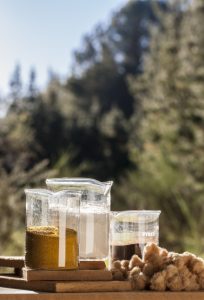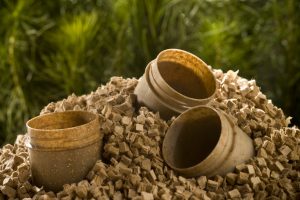Keynote speaker at the IUFRO Regional Congress for Asia and Oceania – Forests for Sustainable Development: The Role of Research
Forests and the Bioeconomy: challenges and opportunities

Dr. Elspeth MacRae. Scion Photo
Innovative technologies for bio-energy, bio-materials and other products will be one of the major themes at the IUFRO Regional Congress for Asia and Oceania on 24-27 October 2016 in Beijing, China. Dr Elspeth MacRae leads wood and fibre processing activities, including biorefinery, biodiscovery and bioplastics at Scion, New Zealand. Her keynote speech will highlight state-of-the-art biotech research and the role of bioproducts.
Q: Dr MacRae, you are General Manager for Manufacturing and Bioproducts at Scion, New Zealand. Could you briefly outline what this involves?
A: It means looking to the future and developing technologies for biorefineries while still maintaining capabilities for today’s challenges. The four teams in our Manufacturing and Bioproducts areas include plant and industrial biotechnology, biopolymers and biochemicals, engineered wood and fibres for multiple applications, and bioenergy and environmental technologies. We take side streams and turn them into new products. We create new trees for different applications.
Q: The world is placing great hopes in the development of materials, chemicals and fuels made of renewable resources. Are these expectations realistic?-

Ingredients for a 100% biobased adhesive (Ligate™) that can be used to make plywood with very low VOC. Scion photograph
A: Yes – it wasn’t really that long ago that our resources were renewable, then people discovered what you could do with petroleum. The challenge is that we won’t be able to fully replace petroleum products in some areas, but that we should try. Many new materials and products are likely to be a blend of both. New types of products that petroleum cannot provide are expected to be developed.
Q: Does it really matter if these things are made from renewable resources?-
A: Yes it matters for two major reasons: 1. Climate change – many non-renewable resources are becoming more scarce and also contribute significantly to increased greenhouse gases; 2. End of life – designing materials and products to be recyclable and/or biodegradable allows less wastage and reduces the pressure on using non renewables that we still need to use. Finally using renewable resources changes the dynamics of trade, with some countries having a greater advantage in providing and using renewables compared to petroleum or shale.
Q: Can you give an example (or examples) of a product that people might see as a game-changer? If that product is not available now, what would be the probable timeline for it to be widely available?
A: An example is natural fibre replacing glass fibre in multiple products, including the automotive industry. This is primarily game changing through light weighting but also end of life options. Glass fibre is heavy and lasts years in landfills. These products are becoming available but are generally challenged for consistency of fibre quality, ability to drop in to current plastics manufacturers’ processing lines and cost. Such fibres are already being produced.
Q: What is the role of forests as a resource in this context, and how do you see the role of planted forests for fostering a greener economy?-
A: Forests are probably the best option for providing consistent and long-term easily available materials. Planted forests can be designed to provide the key materials wanted. For example, we could have very short rotation forests to provide the material for biorefineries – chemicals produced by the trees and fibre as a waste stream for bioenergy or other fibre applications (including cellulose and lignin as components of fibre). We could also grow fibre only forests, or, as we do today, trees for timber and side streams for fibre and other materials. Trees grow in many non-agricultural lands and, in addition, planted forests can also become long-term carbon capture and biodiversity homes as many are today.

Woodfibre dice (Woodforce) used for making natural fibre-plastic composite products and hot-fill cosmetic pots made from PLA and wood flour. Scion photograph
Q: If we look at the region of Asia and Oceania in particular, what would you say are the main challenges and opportunities for developing and using forest-based biotechnology products?-
A: The main challenges are to use land that is not being used now, developing the infrastructure to process the trees close to where they are planted (or alternatively a viable logistics approach). In some parts the processing and product development structure is also not present.
Q: How might the challenges be overcome?-
A: Clustering companies near forests where the waste stream of one can benefit another is one way to help build relevant infrastructure. Another is to develop modular and distributed processing approaches. This isn’t new really – think of the mobile wood-saw operation. Another consideration is how fast 3D printing is being used to replace parts manufacture and storage – the materials to use in 3D printing can come from trees, and you can imagine how the whole value chain can shift to one of local materials and local manufacture.
Q: You have been involved with IUFRO for many years, among other things as a member of the former Task Force on Forest Bioenergy. How can IUFRO, in your view, contribute to the development of a forest-based bio-economy?-
A: I think IUFRO can wholeheartedly embrace the opportunities available by providing scientific evidence about planted forests and the thinking that we could “crop” forests so that you might have several rotations in the same time frame as one at present. Trees have always been used for many things including energy and chemicals.
Q: On a personal level, what do you see as your major research achievement?-
A: Not sure about this one. My personal major research achievement is actually being part of the team that discovered the gene family that makes sucrose in plants, the critical sugar that is found only in plants and some plant like microbes and is responsible for moving carbon around a plant and for ensuring energy supply to various processes. A second would be in taking plant genes that make terpenes and applying them in biorefineries at an early stage in their discovery. Lastly aspects of development of kiwifruit as a global fruit crop.
Q: As an accomplished female scientist, you are a role model for other women who may wish to pursue a career in science. Do you have a message for them?-
A: Follow your instincts, plan your research well, but ensure you imagine the impossible so that you are always stretching in your thinking.
Thank you very much!

Posted by Homepage on
… [Trackback]
[…] Informations on that Topic: blog.iufro.org/2016/09/01/interview-with-dr-elspeth-macrae-scion-new-zealand/ […]